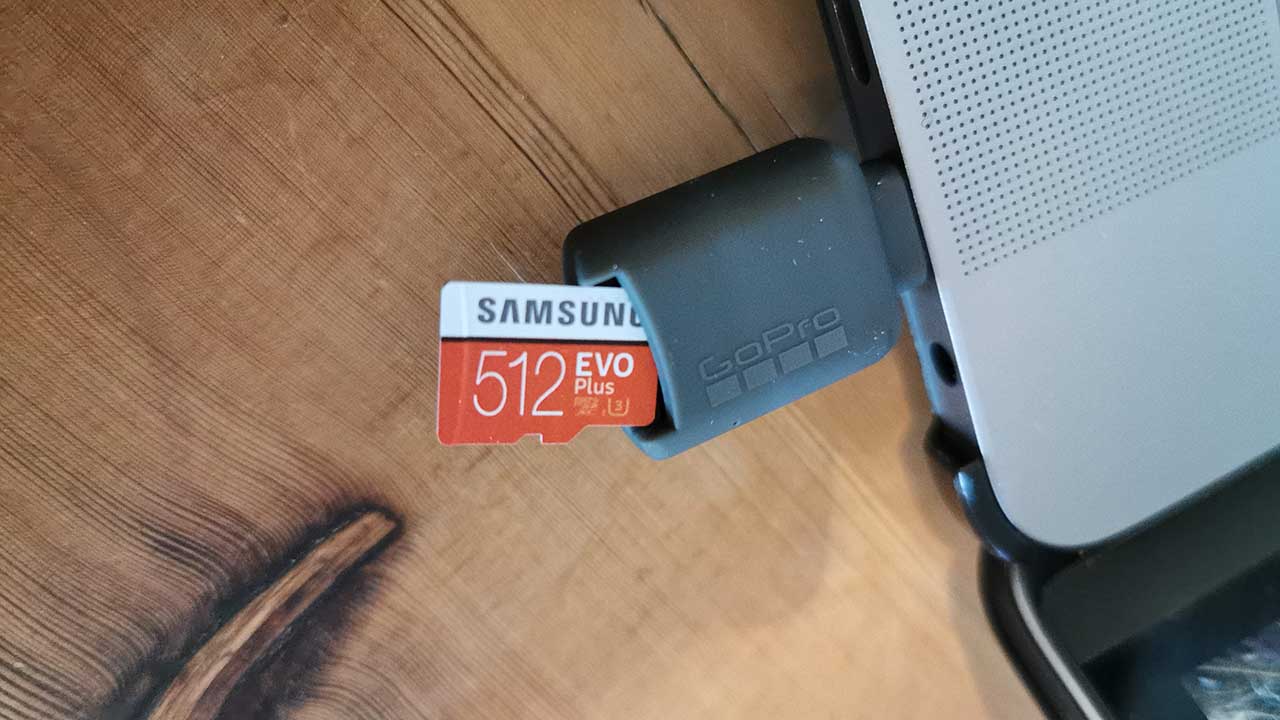By any measure, 512GB is quite a bit of storage, especially when it comes to memory cards. Samsung’s EVO Plus 512GB MicroSDXC is the highest capacity MicroSD card I’ve ever tested, and at just over £160 it’s not badly priced.
However, check through the spec’s of most devices and you’ll notice that the max capacity for most is 128GB or 256GB at a push. So what is the point of a card with a capacity so high you can’t use it?
An increasing amount of laptops, of course not Apple, feature expansion slots and MicroSD card readers, pop this card in and you’ll instantly expand your storage by a massive 512GB.
Likewise, these small cards, once popped into an adapter will function perfectly well as SD card for your mirrorless or DSLR camera.
MicroSD cards in the imaging game are more commonly associated with Action cameras, so I was keen to see if this card would fit and work in some of the most common. GoPro being at the forefront, but I also checked SJCAM, Olfi and a few others.
For all action cameras, each stated the MicroSD card was well above the maximum capacity handled by the camera. So, it’ll be interesting to see if the card is recognised and if it works.
Features
The EVO Plus MicroSDXC comes in a choice of five capacities; 32, 64, 128, 256 and the 512GB version I’m looking at.
The card is rated as a Grade 3 and Class 10 with a maximum read speed of 100MB/s and Write Speed of 90MB/s.
For a UHS-I card, these values seem very high, especially for this capacity card.
Being Samsung the card is well spec’d when it comes to protection with built-in water, temperature, X-Ray and magnet proof. It’s not loss proof which is the most common issue with these cards.
This means that the card has been certified waterproof with IEC 60529 and IPX7 ratings.
The IPX7 rating means, in real terms, the card should be ok for a quick dunk into the water at a depth of up to 1m. If any water that does get in, it shouldn’t cause the card any issue.
That means it should be fine if submerged in water, but make sure it’s thoroughly dry before you use it again.
Operating temperatures are between -25℃ to 85℃ which is more than me, anything below or above these two extremes and card won’t function, the likely hood is neither will I.
Performance
As the capacity of the card is so big, I had to look at several ways to test it, starting with it being used as additional laptop storage. To this end, the card worked solidly over a period of two weeks.
At regular intervals, I tested the card for speed and reliability and averaged a Write speed of 80.2MB/s and Read speed of 91.7MB/s. That’s impressive by any stretch!
The next test was to use the card within the SD card adapter in the Sony A7 Mark III for a shoot. Here the card performed well for stills images with all images being written to the card without corruption or error.
The additional capacity was a welcome enabling me to keep on shooting through three battery changes and two days without clearing the card.
At the end of the shoot, there was still plenty of room left on the card. After several more shots and ensuring the card was full a complete transfer of the entire card to backup drive over USB-C was estimated at 2hrs.
I have to say I felt nervous about using such a large capacity card, but throughout the shoots, the card performed well and without issue.
When it came to video, the Sony A7 Mark III requires a UHS-II card for XAVCHD recording, however swapping to an older camera and testing the card recording 1080p and everything worked perfectly.
Finally, the card was popped into the GoPro Hero 7 Black. This camera stipulates that the maximum capacity that it will recognise is 128GB.
The card was recognised without issue and filming at 4K as well using to take a time-lapse over a week all proved excellent, filling the full 512GB with images.
The card worked and I didn’t have an issue, but I wouldn’t recommend exceeding a cameras maximum capacity with storage. It may work fine but is far more likely to fail.
After the main tests are complete, it’s time to try to destroy the card, I don’t have an X-ray, but water and magnets are plentiful.
The first test is to place the card with data directly onto the back of my monitor speaker to see if after a day on the heat sink the magnetism and heat will affect the contained data.
After a day the card was tested, and all data appeared to be readable and more importantly still intact.
Next, the killer test, drop it in a glass of water and leave it for ten minutes. After retrieving the soggy card and then returning it to the heat sink on the back of the speaker for some drying, I then tested the card again. Again all seems good and working.
Overall an impressive performance all round from this large capacity MicroSD card.
Verdict
After a few weeks of testing the card, I’m impressed with the performance and durability.
It stood up to the tests thrown at it well; it survived being submerged in water, exposed to magnetism and heat and used continuously over a weeklong period to capture a timelapse.
In speed tests I wasn’t expecting the performance the card gave, 80.2MB/s Write and 91.7MB/s Read might not be the 100MB/s and 90MB/s stated by Samsung, but it’s close.
If you’re looking at this card as an option then do make sure you get the capacity of card for the device you’re using. The performance of the 512GB gives me confidence that the rest of the range will perform equally well.
For added storage for a compatible mobile device or laptop then this is an ideal solution.
As a mass storage memory card for your camera then, through this test it seems to perform as well as the larger full SD version.
For action cameras, then go for the 128GB version which will ensure that it works perfectly in almost all camera models.
Samsung’s EVO Plus 512GB MicroSDXC is an impressive card with a huge capacity. It might not be suitable for all devices, but its quality and robustness of storage media makes it a winner.



